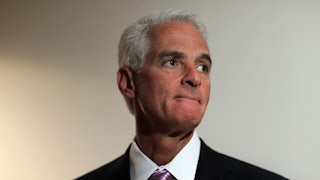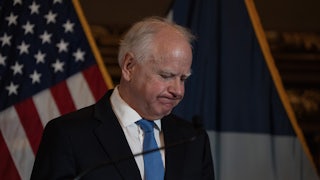Ted Cruz is excited about his “spicy tacos” in South Texas.
“My job was easy,” Cruz beams about the fundraisers he hosts for three Latina Republican House candidates: Monica De La Cruz, Mayra Flores, and former Cruz staffer Cassy Garcia.
“I essentially had to get out of the way and let them shine. They quickly dubbed themselves the spicy tacos, with apologies to Jill Biden,” laughs the senator, referencing a widely criticized gaffe by the first lady in remarks to a Latino audience.
While conventional wisdom suggests Cruz is correct that the rightward shift of Latino voters will turn South Texas red in the midterms, national polling shows Latino voters still favor Democrats by wide margins. The spicy tacos could win all three House races in South Texas, but it’s more likely that they’ll pick up just one or two of the seats.
The stakes couldn’t be higher for both parties at the polls next month, especially after Donald Trump over-performed with Latinos in Florida and Texas in 2020. Neither party can win the White House in two years without significant Latino support, while a half-dozen House seats are up for grabs now by Latino candidates from both parties.
De La Cruz’s race against Michelle Vallejo is the easiest pickup opportunity for Republicans in South Texas after the Democratic Congressional Campaign Committee did not invest in the race. Axios now reports that the House Majority PAC is canceling its ad reservations for Vallejo, an ominous sign for the Democrat.
“If they end up winning that seat, the media will run with a narrative that ignores the fact that the district was redrawn,” said Joaquin Castro, the two-term House Democrat from San Antonio, but it was a Democratic retirement, not Republican redistricting, that brought Flores to Washington in June.
Flores won a special election after Democrat Filemon Vela promptly retired midterm, making Flores the first House Republican from the Rio Grande Valley since 1871. Her Democratic opponent is a fellow incumbent, Vicente Gonzalez, who stumbled early by advertising with a blogger who dubbed Flores “Miss Frijoles” and other racial epithets.
“It was unfortunate,” Gonzalez told me in July, after immediately canceling future advertising with the blogger. “I clearly condemn what was said … and no different than I condemned Donald Trump for saying that Mexico isn’t sending their best and that they send murderers and rapists. That was just as offensive to me.”
Gonzalez saw his district redrawn last year, forcing the two-term Texas Democrat into a head-to-head match with the formidable Flores, who has built a huge following online. Flores, an immigrant from Tamaulipas, Mexico, was celebrated in a June ceremony on the House steps where I asked House Minority Leader Kevin McCarthy about Trump’s infamous 2015 remarks about Mexican immigrants that launched his presidential campaign.
Flores is “the very best,” said McCarthy, pointing out that she is a naturalized American citizen. “She’s standing before you right now … as the first woman born in Mexico ever elected to this body, where less than 12,000 people have ever had that honor [of becoming a member of Congress], and that’s the question you ask?”
There are currently 46 Latinos serving in Congress—33 Democrats and 13 Republicans. Democratic election consultant Chuck Rocha predicts the number of Republican Latinos in the House won’t change, while House Democrats will add six: Robert Garcia and Rudy Salas in California, Delia Ramirez in Illinois, Maxwell Frost in Florida, Greg Casar in Texas, and either Gabe Velasquez in New Mexico or Andrea Salinas in Oregon.
Daniel Garza, executive director of the conservative Libre Initiative, predicts Democrats will lose up to three Latinos in the House, while the GOP will add three to five Latinos to their House caucus. Whatever the outcome, the midterm elections will be another case study in Latino voter behavior to be examined and applied to the presidential race, where Latino voters have proven to be a dynamic and unpredictable demographic over the decades.
Flores told the San Antonio Express-News that, on her father’s advice, she voted for Barack Obama in 2008. Obama’s presidential reelection four years later is the high-water mark for Democratic outreach to Latino voters. Seventy-one percent of Latinos picked Obama compared to 27 percent who picked Mitt Romney.
“If they want a different direction, they gotta choose a different party,” said Romney, now the junior senator from Utah, when I asked him about a Pew poll showing seven in 10 Latinos are dissatisfied with the direction of the country—a jump from 49 percent last March.
Last July, I asked House Speaker Nancy Pelosi what Democrats should be doing to thwart the rightward shift of Latino voters. “Part of our issue in the last election was we couldn’t go door to door to get out the vote,” she said, adding how proud she was of the Congressional Hispanic Caucus members for elevating Latino priorities. “Some of the issues are newer issues to the discussion.”
But several Hispanic Caucus members I spoke with for this story said Latinos determine their vote based on how pocketbook issues affect them. “Many are low-wage earners,” said Representative Chuy Garcia, a Democrat from Illinois. “Inflation proportionally takes a bigger bite out of their paychecks. Cost of living is tough. Many have to drive to work. Gas prices are high. So I think [the dissatisfaction] is an expression of that in totality.”
Despite the hardships facing Latino families, the latest polling shows Latino views of Democrats are generally positive. Nearly three-quarters of Latino adults say Democrats work hard for their votes, while 60 percent believe Democrats represent their interests. Latinos answered favorably for Republicans 45 and 35 percent of the time, respectively, when asked the same.
“Republicans are a brand that are attacking Latinos,” said Representative Tony Cárdenas, a four-term California Democrat. “Republicans have polarized the country when it comes to immigration. The word immigration for Republicans is an attack on mostly Latinos.”
Few believe Republicans will win Latino majorities nationwide anytime soon, but the marginal gains Donald Trump made with Latino voters after years of demonizing immigrants while aggressively courting voters surprised a political establishment that hadn’t done its research.
“I was not particularly surprised by our gains with Hispanics,” said Giancarlo Sopo, a Trump campaign operative focused on Latino voters in 2020, by email. “We saw in the 2016 Florida numbers that Senator Rubio had outperformed then-candidate Trump in neighborhoods with large pockets of Republican and independent Hispanic voters, like Hialeah and Kendall. We also saw how well Senator Rick Scott performed with Boricuas in Central Florida and how, in Texas, Governor Abbott won 42 percent of Latinos (mostly Mexican Americans) in 2018. So we knew that with the right message and smart outreach, we could make significant inroads.”
Still, Trump lost the overall Latino vote in a landslide. “If you actually study the numbers, there was actually a very strong vote for Joe Biden” among Latinos, Pelosi told me last July. In 2020, Biden won Latino voters by a margin of 2-to-1 overall, and 3-to-1 in battleground states Wisconsin and Pennsylvania. “That’s an overwhelming victory,” Representative Joaquin Castro of Texas said. “I think the Republican Party has a long way to go in demonstrating that it can not only attract but sustain Latino support in Texas.”
Cruz, not surprisingly, disagrees. “We’re looking at a fundamental generational shift,” said Cruz, vowing to continue campaigning for the three “spicy tacos” in South Texas and other Latina candidates across the country, including Catalina Lauf in Illinois, Anna Paulina Luna in Florida, and Yesli Vega in Virginia. “I gotta say the business leaders at the fundraiser I hosted for them were blown away.”
Back in South Texas, it’s unclear if Cruz’s fundraising efforts will be enough for Cassy Garcia, his former aide, in a tight race against incumbent Democrat Henry Cuellar. “They know me,” said Cuellar, a border Democrat from the Rio Grande Valley, of his constituents.
Cuellar survived a strong progressive primary challenge from Jessica Cisneros earlier this year despite his opposition to abortion rights and despite the FBI raiding his home and campaign headquarters. Pelosi backed Cuellar as a practical matter, fearing that Cisneros’s policies, especially on climate and abortion, would cost Democrats the seat.
Democratic House leadership’s relationship with Cuellar exemplifies, in many ways, the complex relationship both parties have with Latino voters. Just as GOP leadership must concede a majority of Latino voters by including a chorus of xenophobes on its party ticket, Democrats feel they must back anti-abortion, anti-climate lawmakers like Cuellar to keep themselves in play.
Latinos are the new swing voters. There is no such thing as “the Latino vote.” There are numerous Latino votes. The burgeoning demographic can no longer be considered a reliable supporter of either party. Barack Obama’s success in the demographic offered an illusion that Latinos would permanently be part of the Democratic coalition. The midterms will be an indicator of how much Trump’s successes with Latino voters last election cycle brought the pendulum swinging back—and of where things are headed in 2024, when Latino voters will constitute crucial blocs in key swing states.






